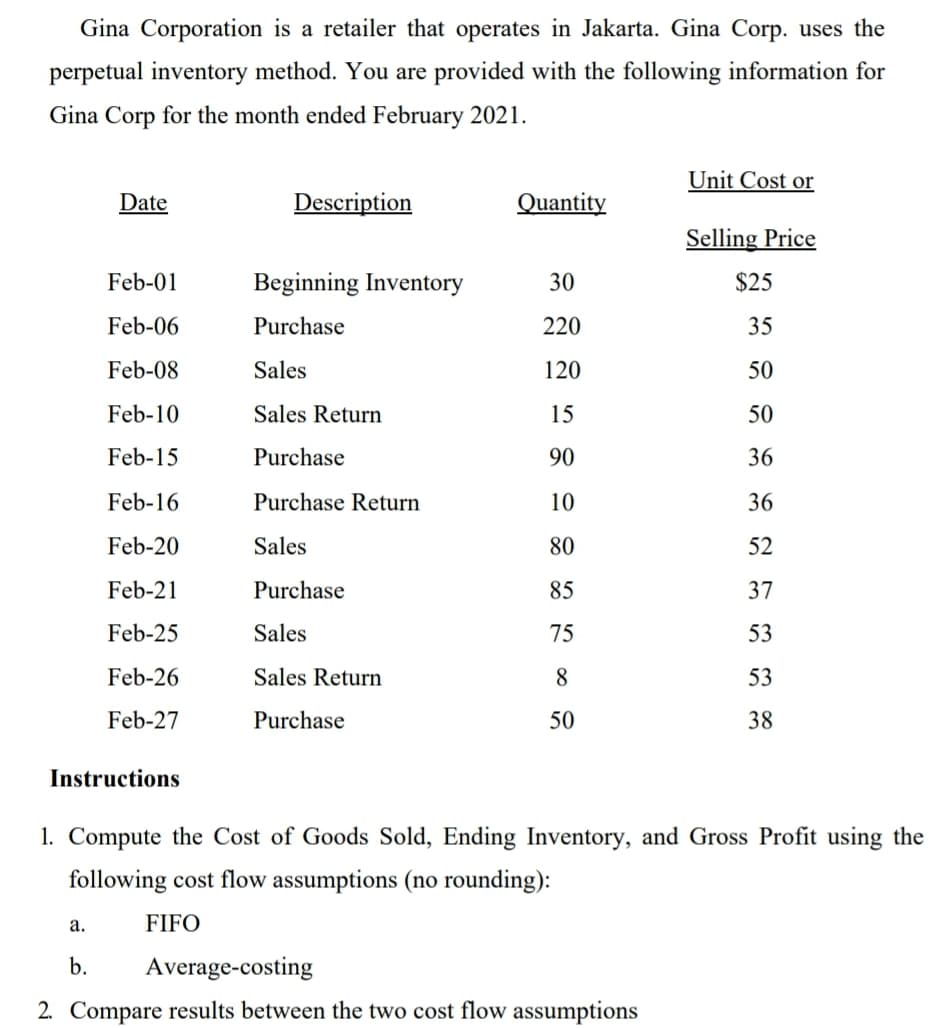Feb-16 Purchase Return 10 36 Feb-20 Sales 80 52 Feb-21 Purchase 85 37 Feb-25 Sales 75 53 Feb-26 Sales Return 8 53 Feb-27 Purchase 50 38 Instructions 1. Compute the Cost of Goods Sold, Ending Inventory, and Gross Profit using the
Feb-16 Purchase Return 10 36 Feb-20 Sales 80 52 Feb-21 Purchase 85 37 Feb-25 Sales 75 53 Feb-26 Sales Return 8 53 Feb-27 Purchase 50 38 Instructions 1. Compute the Cost of Goods Sold, Ending Inventory, and Gross Profit using the
Intermediate Accounting: Reporting And Analysis
3rd Edition
ISBN:9781337788281
Author:James M. Wahlen, Jefferson P. Jones, Donald Pagach
Publisher:James M. Wahlen, Jefferson P. Jones, Donald Pagach
Chapter7: Inventories: Cost Measurement And Flow Assumptions
Section: Chapter Questions
Problem 12RE: Carla Company uses the perpetual inventory system. The following information is available for...
Related questions
Question
Use perpetual system

Transcribed Image Text:Gina Corporation is a retailer that operates in Jakarta. Gina Corp. uses the
perpetual inventory method. You are provided with the following information for
Gina Corp for the month ended February 2021.
Unit Cost or
Date
Description
Quantity
Selling Price
Feb-01
Beginning Inventory
30
$25
Feb-06
Purchase
220
35
Feb-08
Sales
120
50
Feb-10
Sales Return
15
50
Feb-15
Purchase
90
36
Feb-16
Purchase Return
10
36
Feb-20
Sales
80
52
Feb-21
Purchase
85
37
Feb-25
Sales
75
53
Feb-26
Sales Return
8
53
Feb-27
Purchase
50
38
Instructions
1. Compute the Cost of Goods Sold, Ending Inventory, and Gross Profit using the
following cost flow assumptions (no rounding):
а.
FIFO
b.
Average-costing
2. Compare results between the two cost flow assumptions
Expert Solution
This question has been solved!
Explore an expertly crafted, step-by-step solution for a thorough understanding of key concepts.
Step by step
Solved in 3 steps with 10 images

Knowledge Booster
Learn more about
Need a deep-dive on the concept behind this application? Look no further. Learn more about this topic, accounting and related others by exploring similar questions and additional content below.Recommended textbooks for you

Intermediate Accounting: Reporting And Analysis
Accounting
ISBN:
9781337788281
Author:
James M. Wahlen, Jefferson P. Jones, Donald Pagach
Publisher:
Cengage Learning

Principles of Accounting Volume 1
Accounting
ISBN:
9781947172685
Author:
OpenStax
Publisher:
OpenStax College


Intermediate Accounting: Reporting And Analysis
Accounting
ISBN:
9781337788281
Author:
James M. Wahlen, Jefferson P. Jones, Donald Pagach
Publisher:
Cengage Learning

Principles of Accounting Volume 1
Accounting
ISBN:
9781947172685
Author:
OpenStax
Publisher:
OpenStax College


Financial And Managerial Accounting
Accounting
ISBN:
9781337902663
Author:
WARREN, Carl S.
Publisher:
Cengage Learning,

Financial Accounting
Accounting
ISBN:
9781337272124
Author:
Carl Warren, James M. Reeve, Jonathan Duchac
Publisher:
Cengage Learning

Financial Accounting
Accounting
ISBN:
9781305088436
Author:
Carl Warren, Jim Reeve, Jonathan Duchac
Publisher:
Cengage Learning